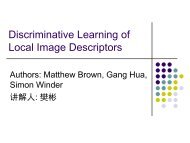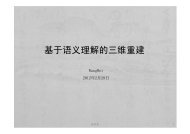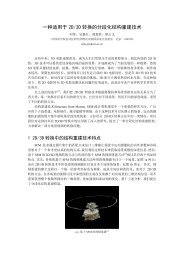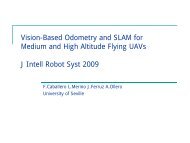Rotationally Invariant Descriptors using Intensity Order ... - IEEE Xplore
Rotationally Invariant Descriptors using Intensity Order ... - IEEE Xplore
Rotationally Invariant Descriptors using Intensity Order ... - IEEE Xplore
Create successful ePaper yourself
Turn your PDF publications into a flip-book with our unique Google optimized e-Paper software.
This article has been accepted for publication in a future issue of this journal, but has not been fully edited. Content may change prior to final publication.<br />
<strong>IEEE</strong> TRANSACTION ON PATTERN ANALYSIS AND MACHINE INTELLIGENCE 8<br />
To this end, we collected 40 image pairs with rotation transformation (some ofthemalsoinvolve<br />
scale changes) from the Internet [43], each of which is related by a homography that is supplied<br />
along with the image pair. They are captured from five types of scenes as shown in Fig. 1 in the<br />
supplemental material. For each image pair, we extracted SIFT descriptors of the SIFT keypoints<br />
and matched them by the nearest neighbor of the distances of their descriptors. We focus on the<br />
orientation estimation errors between corresponding points. For a pair of corresponding points<br />
(x, y, θ) and (x ′ ,y ′ ,θ ′ ), the orientation estimation error is computed by:<br />
ε = θ ′ − f(θ; H) (1)<br />
where f(θ; H) is the ground truth orientation of θ when warping from the first image to<br />
the second image according to the homography H between the two images. Fig. 2 presents<br />
some statistical results. Fig. 2(a) is the histogram of orientation estimation errors among all<br />
corresponding points. A similar histogram was obtained by Winder and Brown [33] by applying<br />
random synthetic affine warps. Here we use real image pairs with mainly rotation transformation.<br />
Fig. 2(b) shows the histogram of orientation estimation errors among those corresponding points<br />
that are matched by their SIFT descriptors. Fig. 2(b) indicates that for SIFT descriptor, orientation<br />
estimation error of no more than 20 o is required in order to match corresponding points correctly.<br />
However, it can be clearly seen from Fig. 2(a) that many corresponding points have errors larger<br />
than 20 o . Only 63.77% of the corresponding points have orientation estimation errors in the<br />
range of [-20 o ,20 o ]. Those corresponding points with large orientation estimation errors (≥ 20 o )<br />
may not be correctly matched by comparing their descriptors. In other words, 36.23% of the<br />
corresponding points will be incorrectly matched mainly due to their large orientation estima-<br />
tion errors. Therefore, orientation estimation has a significant impact on distinctive descriptor<br />
construction.<br />
In order to give more insight into the influence of the estimated orientation on the matching<br />
performance of local descriptor, we conducted some image matching experiments. The experi-<br />
mental images downloaded from the Internet [43] are shown in Fig. 3. The tested image pairs<br />
are selected with the most challenging ones among those in the dataset to perform experiments<br />
on image blur, JPEG compression and illumination change, i.e., the 1st and the 6th images in the<br />
dataset. For each image pair, there exists a global rotation between the two images. Specifically,<br />
0 o for image pairs in Fig. 3(d)-3(f), and a certain degree for image pairs in Fig. 3(a)-3(c). We<br />
November 26, 2011 DRAFT



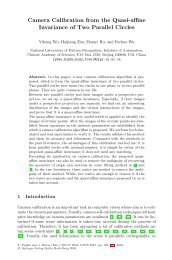
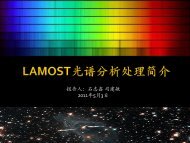
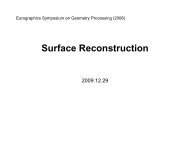
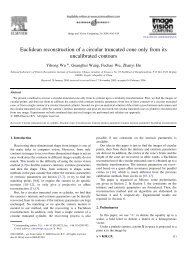
![Accurate, Dense, and Robust Multi-View Stereopsis (PMVS) [1,2,3]](https://img.yumpu.com/19388840/1/190x135/accurate-dense-and-robust-multi-view-stereopsis-pmvs-123.jpg?quality=85)
